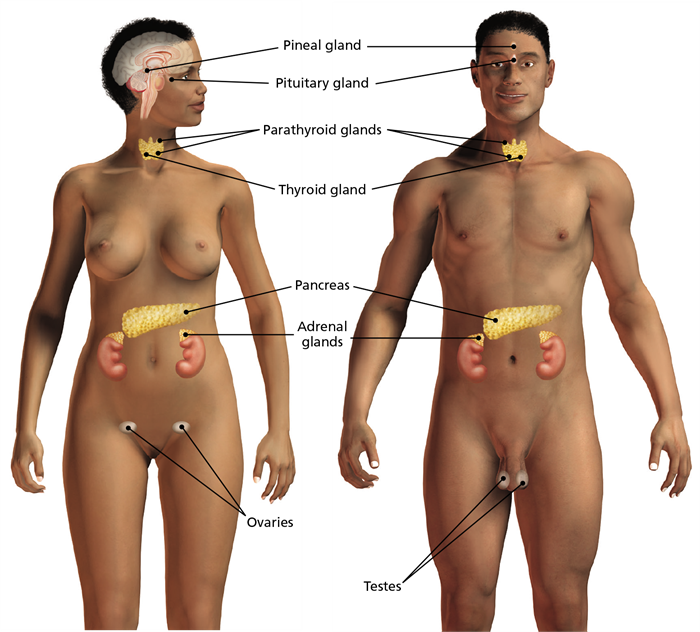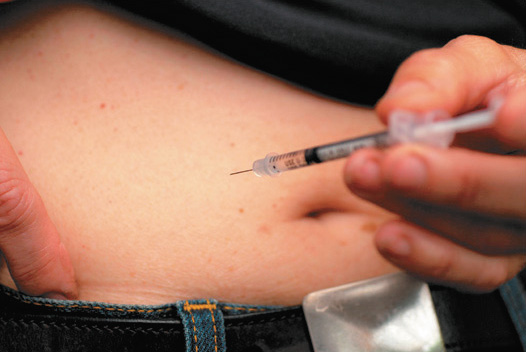Glands and Hormones
Some glands, such as salivary glands and sweat glands, secrete their chemicals directly onto the body’s tissues through tiny tubes, or ducts. This kind of gland affects the functioning of the body but doesn’t really affect behavior. Other glands, called endocrine glands, have no ducts and secrete their chemicals directly into the bloodstream. (See Figure 2.9 .) The chemicals secreted by this type of gland are called hormones. As mentioned earlier in the chapter when talking about the sympathetic division of the autonomic nervous system, these hormones flow into the bloodstream, which carries them to their target organs. The molecules of these hormones then fit into receptor sites on those organs to fulfill their function, affecting behavior as they do so. As compared to synaptic communication, endocrine communication is generally slower due to the time it takes hormones to travel to target organs; the behaviors and responses they affect may not occur until hours, weeks, or years later.

The hormones affect behavior and emotions by stimulating muscles, organs, or other glands of the body. Some theories of emotion state that the surge in certain hormones actually triggers the emotional reaction (Izard, 1988; Zajonc, 1980, 1984). (See Learning Objective 9.11 .) Some of the hormones produced by endocrine glands also influence the activity of the brain, producing excitatory or inhibitory effects (Schwartz & Javitch, 2013).
The Pituitary, Master of the Hormonal Universe
The pituitary gland is located in the brain itself, just below the hypothalamus. The hypothalamus controls the glandular system by influencing the pituitary. That is because the pituitary gland is the master gland, the one that controls or influences all of the other endocrine glands. One part of the pituitary controls things associated with pregnancy, through the hormone oxytocin, such as production of milk for nursing infants and the onset of labor, as well as the levels of salt and water in the body, through the hormone vasopressin. Another part of the pituitary secretes several hormones that influence the activity of the other glands. Most notable of these hormones is a growth hormone that controls and regulates the increase in size as children grow from infancy to adulthood.
As the master gland, the pituitary forms a very important part of a feedback system, one that includes the hypothalamus and the organs targeted by the various hormones. The balance of hormones in the entire endocrine system is maintained by feedback from each of these “players” to the others.
The Pineal Gland
The pineal gland is also located in the brain, near the back, directly above the brain stem. It plays an important role in several biological rhythms. The pineal gland secretes a hormone called melatonin, which helps track day length (and seasons). In some animals, this hormone influences seasonal behaviors such as breeding and molting. In humans, melatonin levels are more influential in regulating the sleep–wake cycle. (See Learning Objective 4.3 .)
The Thyroid Gland
The thyroid gland is located inside the neck and secretes hormones that regulate growth and metabolism. One of these, a hormone called thyroxin, regulates metabolism (controlling how fast the body burns its available energy). As related to growth, the thyroid plays a crucial role in body and brain development.
Pancreas
The pancreas controls the level of blood sugar in the body by secreting insulin and glucagons. If the pancreas secretes too little insulin, it results in diabetes. If it secretes too much insulin, it results in hypoglycemia, or low blood sugar, which causes a person to feel hungry all the time and often become overweight as a result.

The Gonads
The gonads are the sex glands, including the ovaries in the female and the testes in the male. They secrete hormones that regulate sexual behavior and reproduction. They do not control all sexual behavior, though. In a very real sense, the brain itself is the master of the sexual system—human sexual behavior is not only controlled by instincts and the actions of the glands as in the animal world but also by psychological factors such as attractiveness.
The Adrenal Glands
Everyone has two adrenal glands, one on top of each kidney. The origin of the name is simple enough; renal comes from a Latin word meaning “kidney” and ad is Latin for “to,” so adrenal means “to or on the kidney.” Each adrenal gland is actually divided into two sections, the adrenal medulla and the adrenal cortex. It is the adrenal medulla that releases epinephrine and norepinephrine when people are under stress and that aids in sympathetic arousal.
The adrenal cortex produces over 30 different hormones called corticoids (also called steroids) that regulate salt intake and help initiate more info and control stress reactions; it also provides a source of sex hormones in addition to those provided by the gonads. One of the most important of these adrenal hormones is cortisol, released when the body experiences stress, both physical stress (such as illness, surgery, or extreme heat or cold) and psychological stress (such as an emotional upset). (See Learning Objective 9.5 .) Cortisol is important in the release of glucose into the bloodstream during stress, providing energy for the brain itself, and in the release of fatty acids from the fat cells that provide the muscles with energy.
Overall, the interactions between the sympathetic and parasympathetic systems provide an important framework in how we respond to both internal and external events or challenges. Next we will look at how they work together to protect us, or if activated for too long, can lead to some undesirable effects.